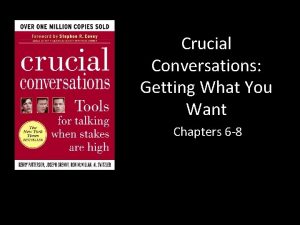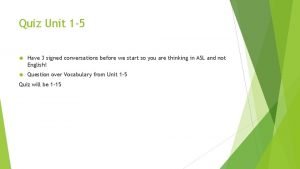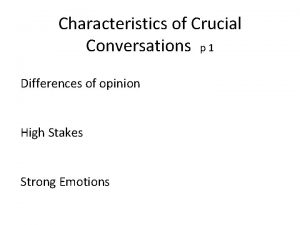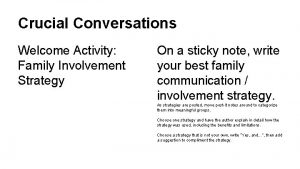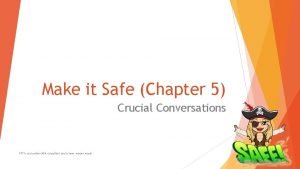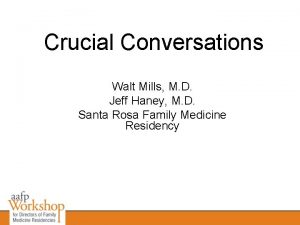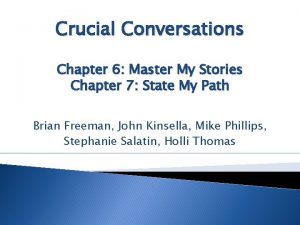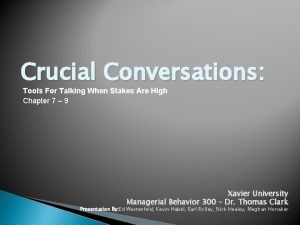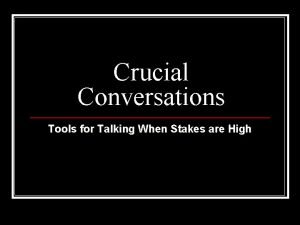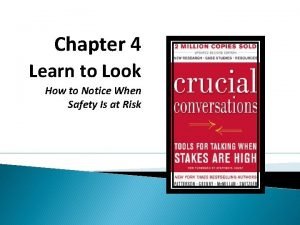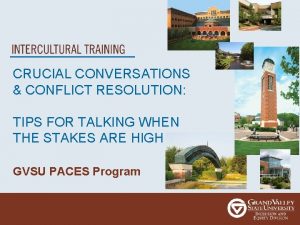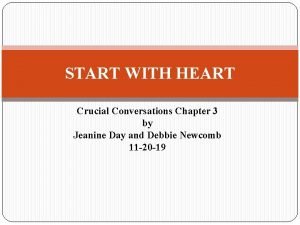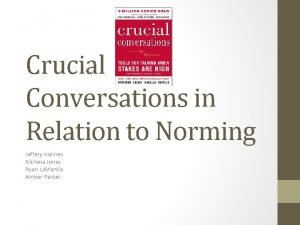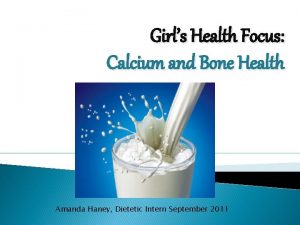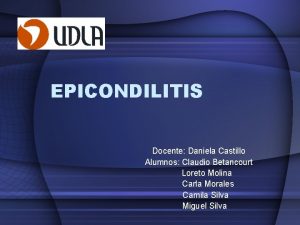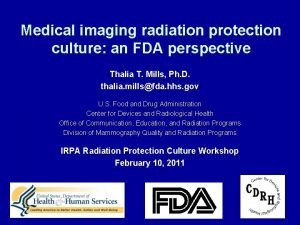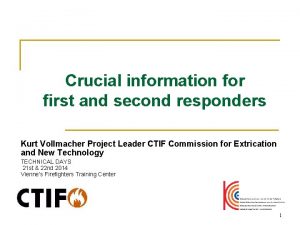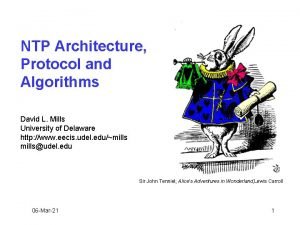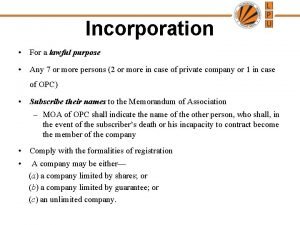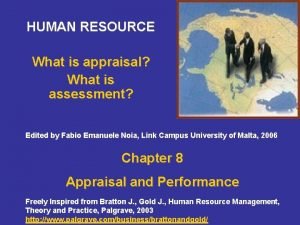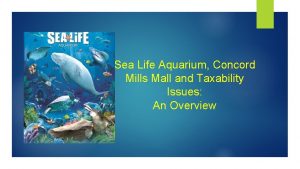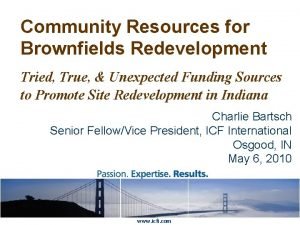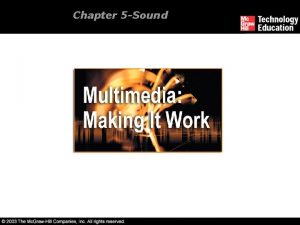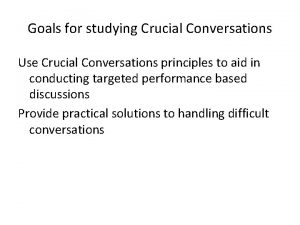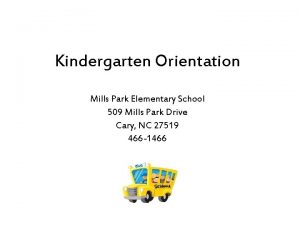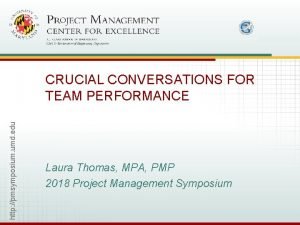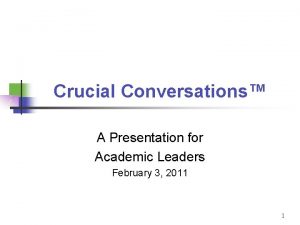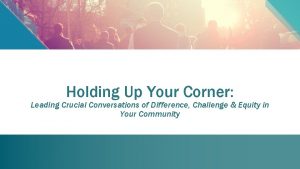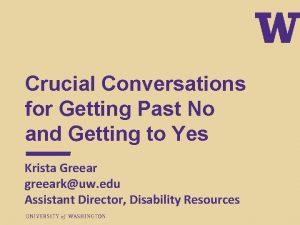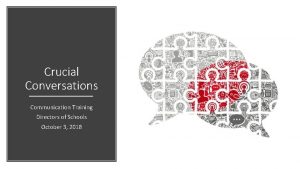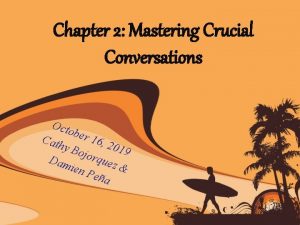Crucial Conversations Walt Mills M D Jeff Haney
































- Slides: 32

Crucial Conversations Walt Mills, M. D. Jeff Haney, M. D. Santa Rosa Family Medicine Residency

Objectives By the end of the session you will be able to: • Define a crucial conversation • Assess your usual approach to stress • Describe a framework for a crucial conversation • Develop a faculty development session using reflection in action

Acknowledgements • Crucial Conversations • Getting to Yes, Getting Past No, Leading Change, Switch • NIPPD+, Penelope Tippy, M. D. and Colleen Conry, M. D. • Kaiser Permanente • Jessica Muller • Lexicon and Jargon

Why should you listen to us? • Lots of practice • Kaiser, Sutter, Community Health Center • INTJ, ENFP • Boomer, Gen Xer • We love the residency

Agenda • Example of a Crucial Conversation • Define Crucial Conversations • Review our defaults in stress • Discuss the seven principles of effective Crucial Conversations • Role Play a Crucial Conversation • Report what you discover

Sample Crucial Conversation • Evaluation of an Intern http: //www. youtube. com/watch? v= 09 bp__4 Muh 8

Ingredients of a Crucial Conversation • Strong Emotions • High Stakes • Opposing Opinions

http: //images. sodahead. com/polls/000894331/reflexes_xlarge. gif

Stress Physiology • • • Adrenals Cortisol Epinephrine Dopamine Tachycardia

http: //img. thesun. co. uk/multimedia/archive/00832/ raymain_832448 a. jpg

During a normal talk

In a Crucial Conversation The Scream, Edvard Munch

During Stress We are Impaired Do you sugarcoat? Do you demand your way? Do you run or avoid? Do you resolve through dialogue and relationship?

Violence Safety Pool of Shared Meaning Safety Silence Actions/Results that hold relationship at the center

Your Approach to Conflict • Avoidant? • Aggressive? • What parts of the relationship do you focus on in conflict?

http: //funnydb. com/big_101218568943. jpg

Online Testing Tool www. vitalsmarts. com/crucialconversations_ book. aspx (it does require you to join for free)

Your Style Under Stress: Silence or Violence: How does it manifest? Dialogue: What are your strengths?

Types of Silence and Violence Withdrawing—Pulling out of communication completely; physical, emotional, psychological Avoiding—staying away from unsafe topics or issues Masking—understating, sugar coating, sarcasm, selectively showing Controlling—coercing others through how we share our views—interrupting, overstating, absolutes Labeling—trying to win or have others give in through ridiculing their ideas Attacking—making sure others hurt; emotional, physical, psychological

The Seven CC Principles 1. 2. 3. 4. 5. 6. 7. Start with Heart Learn to Look Make it Safe Master My Stories State My Path Explore Others’ Paths Move to Action

ME See & Tell a Feel Act Hear Story OTHERS Pool of Shared Meaning Act Feel Tell a Story See & Hear

Principle 1: Start with Heart Identify motives Functional Dysfunctional *The Sucker’s Choice

Principle 2: Learn to Look • Identify when the conversation becomes crucial • Look for signs of deteriorating safety. • CC calls it “using the third eye”… • I call it “Jeff, Do you have two minutes” or…

Principle 3: Make it Safe • Identify Mutual Purpose • Work Toward Mutual Respect

Principle 4: Master My Stories • Know your unbiased story • Encourage clarification of your story • Recognize the bias that enters your story because of your stress tendency

Principle 5: STATE My Path • • • Share your stories Walk them down the path Help them see point A through point Z Avoid antagonism, stick with facts Answer questions/clarify

Principle 6: Explore Others’ Paths What do you do when others move to “silence” or “violence”? • “Inquiry versus Advocacy” • Make yourself curious… learn • “Go to the Balcony” • Listen when others move away from dialogue

Principle 7: Move to Action • How do you make the decision? • Make a plan and follow up

Group Activity • Small Teams (triad) • Think of a personal example or use one we give you • Network • Report to the larger group

Summary of Group Activity

Faculty Development • Reflection in Action • Necessary Resources Two Hours Access to Testing Some basic trust in the group • Results

Information Walt Mills Walter. W. Mills@kp. org Jeff Haneyj@sutterhealth. org 707/583 -8800
 Crucial conversations chapter 6 summary
Crucial conversations chapter 6 summary Difficult conversations role play scenarios
Difficult conversations role play scenarios Constructive structure in asl
Constructive structure in asl Crucial conversations
Crucial conversations The law of crucial conversations
The law of crucial conversations Crucial conversations role play exercises
Crucial conversations role play exercises Crucial conversations chapter 5
Crucial conversations chapter 5 Crucial conversations 7 principles
Crucial conversations 7 principles Crucial conversations
Crucial conversations Conversation
Conversation Contrasting statements crucial conversations examples
Contrasting statements crucial conversations examples Crucial conversations training ppt
Crucial conversations training ppt Crucial conversations chapter 4
Crucial conversations chapter 4 Crucialconversations.com/exclusive mutual respect
Crucialconversations.com/exclusive mutual respect Start with heart
Start with heart Crucial conversations
Crucial conversations Amanda calcium milk
Amanda calcium milk Haney banks and zimbardo
Haney banks and zimbardo Haney banks and zimbardo
Haney banks and zimbardo Rick haney soil test
Rick haney soil test Prueba de la silla epicondilitis
Prueba de la silla epicondilitis Thalia mills fda
Thalia mills fda Ellicott mills middle school staff
Ellicott mills middle school staff Kurt crucial
Kurt crucial David mills ntp
David mills ntp Jubilee cotton mills vs lewis
Jubilee cotton mills vs lewis Performance management is crucial to ______.
Performance management is crucial to ______. Mills mall aquarium
Mills mall aquarium Crescent textile mills company profile
Crescent textile mills company profile Mifflin mills lebanon pa
Mifflin mills lebanon pa Highland mills montessori
Highland mills montessori Artesanato intelectual mills
Artesanato intelectual mills Crucial aspects of preparing digital audio files
Crucial aspects of preparing digital audio files
